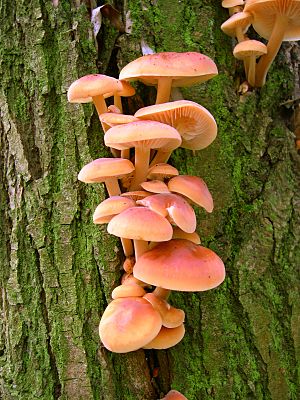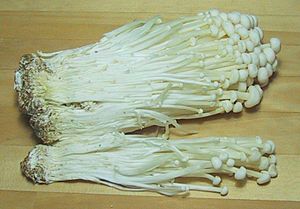Enokitake facts for kids
Quick facts for kids Enokitake |
|
|---|---|
 |
|
| Wild enokitake, Flammulina velutipes | |
 |
|
| Cultivated Flammulina velutipes | |
| Scientific classification | |
| Kingdom: | |
| Division: | |
| Class: | |
| Order: |
Agaricales
|
| Family: |
Physalacriaceae
|
| Genus: |
Flammulina
|
| Species: |
F. velutipes
|
| Binomial name | |
| Flammulina velutipes (Curtis) Singer (1951)
|
|
| Synonyms | |
|
|
Enoki (Flammulina velutipes) is a type of mushroom that you can eat. It's also known as velvet shank. This mushroom is very popular in Japanese cuisine, where people call it enokitake.
You can find enoki mushrooms growing naturally on the stumps of trees like the Chinese hackberry, ash, mulberry, and persimmon. They usually grow from September to March, which is why they are sometimes called "winter fungus." Wild enoki mushrooms look different from the ones grown on farms. They can have different colors, textures, and might be a bit slimy. Wild enoki has many names, including futu, seafood mushrooms, winter mushrooms, velvet foot, or velvet stem.
Contents
What Enoki Looks Like
There's a big difference between how wild enoki mushrooms look and how farmed ones look.
Wild vs. Farmed Enoki
Mushrooms grown on farms are usually white because they don't get much light. Wild enoki mushrooms, however, are often dark brown.
Farmed enoki mushrooms are grown in a special environment with lots of carbon dioxide (CO2). This helps them grow long, thin stems. Wild enoki mushrooms, on the other hand, have much shorter and thicker stems.
Key Features
Flammulina velutipes mushrooms have shiny, sticky caps. Their spores (which are like seeds for mushrooms) are white. You won't find a ring on their stem.
The caps of these mushrooms can be about 1 to 5 centimeters (about 0.4 to 2 inches) wide. Their stalks are usually 2 to 8 centimeters (about 0.8 to 3 inches) long and 4 to 7 millimeters (about 0.16 to 0.28 inches) wide.
Enoki in the Kitchen
Farmed enoki is a long, thin, white mushroom. It's a popular ingredient, especially in East Asian cooking. People often use it in soups, but it's also great in salads and other dishes.
Enoki mushrooms have a crisp texture. You can keep them in the refrigerator for about one week. The long, thin shape of farmed enoki is because of the CO2-rich air used when they are grown.
Farmed enoki is also known as golden needle mushroom, futu mushroom, or lily mushroom. You can buy farmed F. velutipes fresh or in cans.
Different Names for Enoki
| Flammulina velutipes | |
|---|---|
| Mycological characteristics | |
| gills on hymenium | |
| cap is convex | |
| hymenium is adnexed | |
| stipe is bare | |
| spore print is white | |
| edibility: choice | |
The names enokitake, enokidake, and enoki all come from the Japanese language.
In Mandarin Chinese, this mushroom is called 金針菇 (jīnzhēngū), which means "gold needle mushroom." Sometimes it's just called 金菇 (jīngū), or "gold mushroom."
In India, it's called futu. In Korean, it's paengi beoseot, meaning "mushroom planted near catalpa trees." In Vietnamese, it's nấm kim châm. In Hungary, it's called téli fülke, which means "winter ear."
Varieties of Enoki
Scientists have found different types, or varieties, of F. velutipes. In 2015, they described two new varieties based on how they look.
Later, in 2018, they suggested that the Asian enokitake, called F. velutipes var. filiformis, should actually be its own separate species, F. filiformis. This idea came from studying their genetic makeup.
Another variety from western America, F. velutipes var. lupinicola, has also been suggested to be its own species. As of 2020, these new species are recognized by important mushroom databases like MycoBank and Index Fungorum.
What's Inside Enoki Mushrooms
Flammulina velutipes is a good edible mushroom. It might have a soft or slightly slimy texture. The stem of wild enoki is usually too tough to eat. Enokitake mushrooms contain helpful compounds like ergothioneine and terpenes.
Mushrooms That Look Similar
It's important not to confuse enoki with the poisonous mushroom Galerina marginata. That mushroom has brown caps and stems, and its spores are rusty brown. It also tends to grow alone and has a ring on its stem.
Other mushrooms that look somewhat similar to enoki include Flammulina populicola, Connopus acervatus, Gymnopus villosipes, and Gymnopus erythropus.

